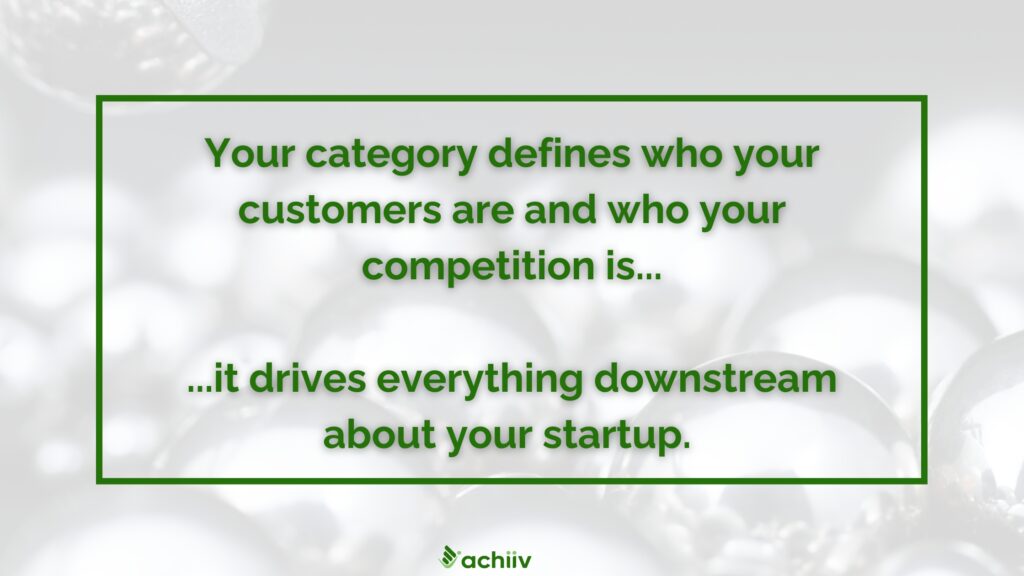An extremely talented founder I know built an innovative startup that leverages AI in a very unique way. As she went about fundraising, she ran into an existential issue that hadn’t seemed salient until then: exactly what category of startup was she building?
- Was it AI?
- Was it in the sector she was looking to disrupt? (let’s say healthcare)
- Was it an enterprise SaaS startup ? (because that was how she made money)
- All of the above? None of the above?
- Did it even matter?
As you focus on the big things funders care about, like your secret sauce, your team, traction and technology, category may be the last thing on your mind. You might even think it’s a trivial issue.
You’d be wrong.
Category is not only significant for matters far beyond which investors you’ll target – it’s the foundation of your entire business strategy. Getting your category right can make or break your startup.
Why Category Defines Destiny:
It’s pretty simple. If you’re selling widgets, you’re in the widget category. So why bother?
Category Frames The Investment Opportunity
The moment you talk to an investor, they want to know – are you going to fit in the box they play in? If your category is not an obvious fit, they make a snap decision to move on.
If your startup has AI playing some meaningful part of the offering, for example, you could fall into at least two categories: AI and your industry.
If you haven’t taken the time to define your category ahead of time, with the rationale to support it, you’ll be at the mercy of whatever category the investor most easily puts your startup into – usually not to your benefit.
No bueno.

Category Defines Your Market
Your category defines who your customers are and who your competition is. It defines what market you’re playing in.
That definition is key because it drives how big your sandbox is. The size of your market is, of course, a huge driver of investors’ interest in your startup.
Your market definition can also drive your cost of doing business up or down, for example, if significant regulations are at play in a specific category but not in others.
Sometimes, you can’t entirely control the category. If you’re Boeing and you sell and finance airplanes, are you in the transportation business or the financing business? Regulators might decide it for you!
Category Drives Business Model and Strategy
Your category frames how customers view you, what “box” they put your offering in. So it drives what they consider value. This perspective drives everything downstream about your startup.
- What price do they consider acceptable?
- What channels will they shop in for this category?
- What kind of margins and returns can you expect for this category?
- Most importantly, what is the growth potential for this category?
There was a founder I talked to who offers software to health systems. This software can provide training, enable clinical research, and do a whole host of other things.
What category is she in?
If her category is ed-tech, that sets her up for a specific price expectation and channel strategy that’s vastly different than if she were a research software provider.
She’d be selling to very different customers even within the same health systems who care about very different things. And also, very different prices they’d be willing to pay as well.
How It Works in The Real World
Say you just invented a smart sleep monitoring device. What category is your product?
Is it a wearable, health tech, or a smart home device, especially if it links to other devices or networks?
How can you make the choice that will best serve you, your startup and your customers?
Here’s a simple guide:
- First, consider customer intent, the most compelling use cases, and who your customers consider to be your biggest competitors.
- Second, consider what selecting each category means for your price, market size, your channel and of course, the potential for profits and growth.
- Finally, choose a defensible category that allows you to justify critical elements of your business model – revenue, channel and growth, in a credible way.
Most importantly, validate your choice. Test your chosen category with your target audience.
Does it resonate with them? Does it accurately reflect your offering?
In this example, you might select the wearables category because your product is most used for personal sleep optimization, with customers looking for it in electronics and tech retailers.
Category selection is best done as an iterative process, as you test out various options and understand the implications on the big questions that drive your startup’s trajectory and potential.

How To Take Action:
Defining your startup’s category is not just a formality; it’s a strategic imperative. It’s also your privilege and opportunity as the founder to shape how investors and customers view your offering.
Get this right, and leverage it for maximum impact:
- Understand what defines your market, and where the gap is
- Generate more possibilities for your category than you think you need
- Play devil’s advocate, use extreme viewpoints to test the solution space
- Think through implications for market size, price, profit and growth
Then define your category.
Above all, use data, data, data to ensure you sharpen and optimize your category over time.
The facts are what help you win every time!
Want more like this? Sign up now for Seed2Success from Achiiv – the weekly digest with insightful podcast episodes, financial storytelling advice, actionable tips and more – 100% free!







